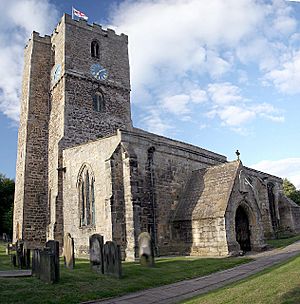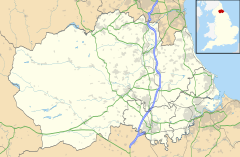Staindrop facts for kids
Quick facts for kids Staindrop |
|
|---|---|
 St Mary's Church, Staindrop |
|
| Population | 1,310 |
| OS grid reference | NZ293106 |
| Shire county | |
| Region | |
| Country | England |
| Sovereign state | United Kingdom |
| Post town | DARLINGTON |
| Postcode district | DL2 |
| Police | Durham |
| Fire | County Durham and Darlington |
| Ambulance | North East |
| EU Parliament | North East England |
| UK Parliament |
|
Staindrop is a village in County Durham, England. It is located about 6 kilometers (4 miles) northeast of Barnard Castle. You can find it along the A688 road. In 2011, about 1,310 people lived here. This number includes the small areas of Cleatlam and Killerby.
Contents
What's in a Name?
The name Staindrop comes from Old English. It means "stony valley." It combines two old words: stǣner (meaning "stony ground") and hop (meaning "valley").
A Look Back in Time
Around the year 1018, King Canute gave the lands of Raby and Staindrop to Durham Priory. This was a large religious house. Later, in 1131, a leader named Prior Algar gave the land to Dolfin, an Anglo-Saxon man. Dolfin was an early ancestor of the important Neville family. This family later built Raby Castle nearby.
This gift might have just confirmed that Dolfin's family already owned the land. This was even before the Norman Conquest in 1066. Dolfin was a very important person. He was likely a noble from Northumbria. In 1203-1204, King John confirmed all the special rights and lands of the priory. This included "Staindrop and Staindropshire with the church."
Famous Buildings in Staindrop
One of the most famous buildings near Staindrop is Raby Castle. This is a medieval castle built a long time ago. It is surrounded by a large park with deer. The castle is about 1.5 kilometers (1 mile) north of the village.
John Neville, 3rd Baron Neville built Raby Castle in the late 1300s. It is still a private home today. The Vane family, also known as the Barons Barnard, live there.
Raby Old Lodge is another old building. It dates back to the 1300s. It used to be an outpost for Raby Castle. It was changed a lot between 1897 and 1899. Now, people can stay there for holidays.
Other important buildings include Scarth Hall. This was built in 1875 as the village hall. During World War II, it was used by the NAAFI. It provided services for soldiers in Staindrop. After being updated in 2016, it is now a community center.
Snotterton Hall was once a strong manor house from the 1400s. It was torn down in 1831. A farmhouse has now been rebuilt on the same spot.
Places of Worship
The Church of England parish church in Staindrop is called St Mary's. It was once named after St. Gregory. This church has Anglo-Saxon parts. Records show the first church here was built in the year 771 AD. The church has been made bigger and changed over many centuries. Inside, you can see monuments and statues of members of the Neville family. The church was restored around 1849. A Congregational chapel also stood here from 1868 until the 1970s.
How Staindrop is Governed
From 1974, Staindrop was part of the Teesdale local government area. This area was removed in 2009. For elections to the Durham County Council, Staindrop is in the Barnard Castle East ward.
The village is part of the Bishop Auckland parliamentary area. This area is currently controlled by the Conservative Party. The person who represents this area in Parliament is called a Member of Parliament. Since the 2019 general election, Dehenna Davison has been the Member of Parliament for Bishop Auckland.
Life in Staindrop
Staindrop has two schools for young people. Staindrop Church of England Primary School has about 170 students aged 3 to 11. Staindrop Academy is a coeducational secondary school. It has over 500 students aged 11 to 16. The academy also has a community gym, which opened in 2020.
The only remaining pub in the village is The Wheatsheaf. It used to be a place where horse-drawn coaches would stop. Other pubs that used to be here include The Black Swan, The Black Lion Inn, and The Royal Oak.
Other useful places in the village include a SPAR shop. There is also a newsagent that has the local post office. You can find a tea room, hairdressers, and several holiday cottages too.
The Staindrop Carnival is a yearly parade and fair. It celebrated its 100th birthday in 2020. The village football team is Staindrop F.C. They play in the Darlington Sunday invitation league. This league is part of the Durham County Football Association. In 2020-2021, they won both the Alan Rusk trophy and the league cup. Raby Castle Cricket Club plays in the Darlington & District Cricket League A. They won their league title in 2019 without losing any games.
Famous People from Staindrop
The surveyor Jeremiah Dixon is buried in Staindrop. A surveyor measures and maps land. Jeremiah Dixon worked with Charles Mason to create the Mason–Dixon line in North America. This line marked a boundary. His grave is unmarked in the Quaker burial ground. This is next to the old Friends' Meeting House. The book Mason & Dixon by Thomas Pynchon mentions Staindrop. It says that Jeremiah Dixon's favorite pub was there.
- Charles Bungay Fawcett was born here on August 25, 1883.
- Charles Wilbraham Watson Ford was born here on July 17, 1896.
- Major William Kemp Trotter, a former Deputy Lieutenant of County Durham, and his wife Mary Holcroft also lived here.


